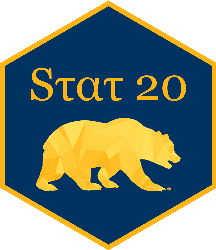40:00
Expected Value and Variance
STAT 20: Introduction to Probability and Statistics
Agenda
- Concept review
- Concept questions
- Worksheet
Recap
Summary
- Data
- Variables
- Categorical
- Numerical
- Histogram
- Mean
- Standard Deviation
- Variance = \(SD^2\)
Probability
- Chance processes
- Random Variables
- Discrete
- Continuous
- Probability Histogram
- Expected Value
- Standard Deviation
- Variance
Expected Value of a Discrete RV
\[ E(X) = \sum_x x \times P(X=x) = \mu \]
EV is the long-term average: the value that you would expected to get if you were to repeat the chance process a very large number of times.
Variance of a Discrete RV
\[ \text{Var}(X) = \sum_x (x - \mu)^2 \times P(X=x) \]
Var is the average squared deviation from the mean (measures the typical spread around EV)
Example: Expected Value
Let \(X\) be the spots when we roll a fair six-sided die.
\[ \Omega = \left \{ 1, 2, 3, 4, 5, 6 \right \} \]
\[ P(X = x) = 1/6, \quad \text{for all } x \]
\[ \begin{align*} EV(X) &= \sum_x x \times P(X=x) \\ &= 1(1/6) + 2(1/6) + 3(1/6) + 4(1/6) + 5(1/6) + 6(1/6) \\ &= \frac{1 + 2 + 3 + 4 + 5 + 6}{6} \\ &= 3.5 \end{align*} \]
Example: Variance
Let \(X\) be the spots when we roll a fair six-sided die.
\[ \Omega = \left \{ 1, 2, 3, 4, 5, 6 \right \} \]
\[ \begin{align*} \text{Var}(X) &= \sum_x (x - \mu)^2 \times P(X=x) \\ &= (1 - 3.5)^2 (1/6) + (2 - 3.5)^2 (1/6) + \dots + (6 - 3.5)^2 (1/6) \\ &= \frac{(1 - 3.5)^2 + (2 - 3.5)^2 + (6 - 3.5)^2}{6} \\ & \approx 2.916 \end{align*} \]
Properties of EV
\(E(c) = c\)
\(E(cX) = c \cdot E(X)\)
\(E(X + Y) = E(X) + E(Y)\)
\(E(aX + bY) = a \cdot E(X) + b \cdot E(Y)\)
\(Y = g(X) \ \rightarrow \ E(Y) = E(g(X)) = \sum_x g(x) \times P(X=x)\)
Properties of Variance
\(\textit{Var}(c) = 0\)
\(\textit{Var}(cX) = c^2 \cdot \textit{Var}(X)\)
\(\textit{Var}(X + c) = \textit{Var}(X)\)
\(\textit{Var}(X + Y) = \textit{Var}(X) + \textit{Var}(Y) \quad \text{ for } X, Y \text{ indep}\)
\(\textit{Var}(X - Y) = \textit{Var}(X) + \textit{Var}(Y) \quad \text{ for } X, Y \text{ indep}\)
Concept Review
Let \(X\) be a random variable such that \[ X = \begin{cases} -1, & \text{ with probability } 1/3\\ 0, & \text{ with probability } 1/6\\ 1, & \text{ with probability } 4/15 \\ 2, & \text{ with probability } 7/30 \\ \end{cases} \]
- Draw the graph of the CDF of \(X\)
Let \(X\) be a random variable such that \[ X = \begin{cases} -1, & \text{ with probability } 1/3\\ 0, & \text{ with probability } 1/6\\ 1, & \text{ with probability } 4/15 \\ 2, & \text{ with probability } 7/30 \\ \end{cases} \]
- Compute the expected value and variance of \(X\)
Concept Questions
\(X\) is a random variable with the distribution shown below: \[ X = \begin{cases} 3, \; \text{ with prob } 1/3\\ 4, \; \text{ with prob } 1/4\\ 5, \; \text{ with prob } 5/12 \end{cases} \]
Consider the box with tickets: \(\fbox{3}\, \fbox{3}\, \fbox{3} \,\fbox{4} \,\fbox{4} \,\fbox{4} \,\fbox{4} \,\fbox{5} \,\fbox{5}\, \fbox{5} \,\fbox{5} \,\fbox{5}\)
Suppose we draw once from this box and let \(Y\) be the value of the ticket drawn.
Which random variable has a higher expectation?
Prof. Stoyanov’s Zoom office hours are not too crowded this spring. She observes that number of Stat 20 students coming to her Thursday office hours have a Poisson(2) distribution. There is one Data 88 student from a previous semester who is always there (they want a letter of recommendation).
What is the expected value (EV) and variance (V) of the number of students in her Zoom office hours?
Let \(X\) be a discrete uniform random variable on the set \(\{-1, 0, 1\}\).
If \(Y=X^2\), what is \(E(Y)\)?
Let \(X\) be a discrete uniform random variable on the set \(\{-1, 0, 1\}\).
If \(W = \min(X, 0.5)\), what is \(E(W)\)?
Worksheet
